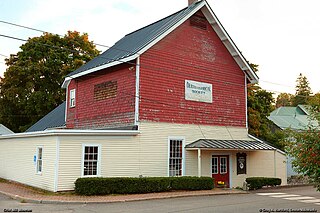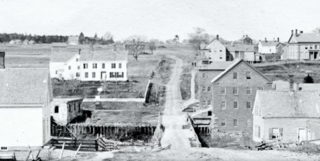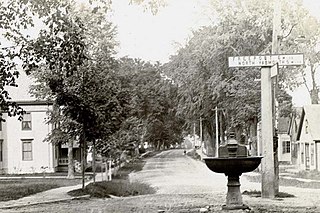
Bradford is a census-designated places in the town of Bradford, Orange County, Vermont, United States. The population was 907 at the 2020 census. The village disincorporated on December 1, 2004. The village became a census-designated place in 2008. The central commercial and residential portion of the village is listed on the National Register of Historic Places as the Bradford Village Historic District.

Grist Mill Park is an urban park in Yarmouth, Maine, United States. Located on East Main Street, in the town's Lower Falls area, and overlooking the Royal River's First Falls from the east, the park partly occupies the former site of a 17th-century sawmill. That mill was built in October 1674 by Englishman Henry Sayward and Colonel Bartholomew Gedney. The foundations of a later mill, Lower Grist Mills, constitutes today's overlook of the river. Lower Grist Mills was built in 1813 and was in business for 36 years, grinding wheat and corn into flour using power generated by the water turbines set in the fast-flowing river below. Between 1870 and 1885, it was the site of Ansel Loring's second mill, named Yarmouth Flour Mill.

The Royal River is a small river, 39 miles (63 km) long, in southern Maine. The river originates in Sabbathday Lake in New Gloucester and flows northeasterly into Auburn and then southerly through New Gloucester, Gray and North Yarmouth into Casco Bay at Yarmouth.

Yarmouth is a town in Cumberland County, Maine, United States, twelve miles north of the state's largest city, Portland. When originally settled in 1636, as North Yarmouth, it was part of the Massachusetts Bay Colony, and remained part of its subsequent incarnations for 213 years. In 1849, twenty-nine years after Maine's admittance to the Union as the twenty-third state, it was incorporated as the Town of Yarmouth.

The Mill at Freedom Falls is a historic mill complex at Mill and Pleasant Streets in Freedom, Maine. The main building, constructed in 1834, is the only mill built at this site, and the only one to survive nearly unaltered in the village. The mill and its surviving dam were listed on the National Register of Historic Places.

The Dexter Grist Mill, now the Dexter Historical Society Museum, is a historic 19th-century industrial property in Dexter, Maine. Built in 1854, the mill was operated by a single family for over a century, and was converted to a museum in 1967. It was listed on the National Register of Historic Places in 1975.
The historical buildings and structures of Yarmouth, Maine, represent a variety of building styles and usages, largely based on its past as home to almost sixty mills over a period of roughly 250 years. These mills include that of grain, lumber, pulp and cotton. Additionally, almost three hundred vessels were launched by Yarmouth's shipyards in the century between 1790 and 1890, and the homes of master shipwrights and ship captains can still be found throughout the town.

Royal River Park is an urban park in Yarmouth, Maine, United States. It is located to the northwest of the town center, between East Elm Street to the west and Bridge Street to the east. U.S. Route 1 runs through the park via an overpass.

Forest Paper Company was a pulp and paper mill on the Royal River in Yarmouth, Maine, United States, which was in business between 1874 and 1923. It was the first of its kind in New England. In 1909, it was the largest such mill in the world, employing 275 people. It produced 80 tons of poplar pulp each day.

Main Street is a historic street in Yarmouth, Maine, United States. It is part of the 18-mile-long (29 km) State Route 115 (SR 115), the eastern terminus of which is in Yarmouth at the intersection of Marina Road and Lafayette Street (SR 88), at Yarmouth Harbor in the Lower Falls area. Its western end is a merging with Walnut Hill Road in North Yarmouth, at which point SR 115 continues west.

Yarmouth Marina is a natural harbor and estuary of Casco Bay, and is located adjacent to the town of Yarmouth, Maine, United States. It is situated on the Royal River, around 0.5 miles (0.80 km) southeast of the town center, in an area known as Lower Falls. Today it functions solely as a marina.

Bridge Street is a historic street in Yarmouth, Maine, United States. It runs for about 0.36 miles (0.58 km) from Willow Street in the north to the town's Main Street, State Route 115, in the south. The street's elevation is around 75 feet (23 m) at each end, while its middle section, at its crossing of the Royal River, is around 13 feet (4.0 m), a drop of around 62 feet (19 m).

Elm Street is a prominent street in Yarmouth, Maine, United States. It runs for about 2.7 miles (4.3 km) from North Road in the north to Portland Street in the south. The street's addresses are split between "West Elm Street" and "East Elm Street", the transition occurring at Main Street in the Upper Village. Several of its buildings are homes dating to the late 18th and early 19th centuries.

The First Falls are the first of four waterfalls in Yarmouth, Maine, United States. They are located on the Royal River, approximately a mile from its mouth with inner Casco Bay at Yarmouth Harbor and around 0.35 miles (0.56 km) downstream of the Second Falls. The river appealed to settlers because its 45-foot rise in close proximity to navigable water each provided potential waterpower sites. As such, each of the four falls was used to power 57 mills between 1674 and the mid-20th century.

The Second Falls are the second of four waterfalls in Yarmouth, Maine, United States. They are located on the Royal River, approximately 1.35 miles (2.17 km) from its mouth with inner Casco Bay at Yarmouth Harbor, and approximately 0.35 miles (0.56 km) upstream of the First Falls. The river appealed to settlers because its 45-foot rise in close proximity to navigable water each provided potential waterpower sites. As such, each of the four falls was used to power 57 mills between 1674 and the mid-20th century.

The Third Falls are the third of four waterfalls in Yarmouth, Maine, United States. They are located on the Royal River, approximately 2.8 miles (4.5 km) from its mouth with inner Casco Bay at Yarmouth Harbor, and approximately 0.4 miles (0.64 km) upstream of the Second Falls. The river appealed to settlers because its 45-foot rise in close proximity to navigable water each provided potential waterpower sites. As such, each of the four falls was used to power 57 mills between 1674 and the mid-20th century.

The Fourth Falls, also known as Upper Falls or Gooch's Falls, are the fourth of four waterfalls in Yarmouth, Maine, United States. They are located on the Royal River, approximately 0.4 miles (0.64 km) upstream of the Third Falls. The river appealed to settlers because its 45-foot rise in close proximity to navigable water each provided potential waterpower sites. As such, the four falls were used to power 57 mills between 1674 and the mid-20th century.

Lower Falls is the colloquial name for the eastern end of Main Street, and part of East Main Street, in Yarmouth, Maine, centered around the former’s intersection with Portland Street. It is also known as Falls Village or The Falls.

Staples Hill is a historical section of Main Street in Yarmouth, Maine. It is located, in what is known as Lower Falls, at Main Street's split with Marina Road. Main Street continues on, down a substantial hill, to First Falls, while Marina Road leads, in a similar fashion, toward Yarmouth Marina, where ships were built between the late 18th and late 19th centuries. Today, both roads join State Route 88 around 450 feet (140 m) apart; historically, however, they provided access to the harbor from the town. The section of Route 88 between the intersections was formerly known as Grantville.




















